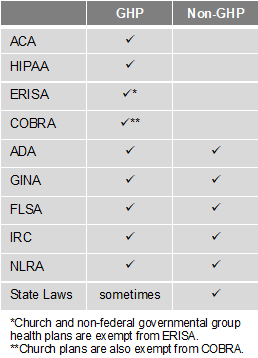
by admin | Aug 15, 2017 | Compliance, Health & Wellness
 Where to Start?
Where to Start?
First, expand the usual scope of wellness activity to well-BEING. Include initiatives that support more than just physical fitness, such as career growth, social needs, financial health, and community involvement. By doing this you increase your chances of seeing a return on investment (ROI) and a return on value (ROV). Qualitative results of a successful program are just as valuable as seeing a financial impact of a healthier population.

Source: Katherine Baicker, David Cutler, and Zirui Song, “Workplace Wellness Programs Can Generate Savings,” Health Affairs, February 2010, 29(2): pp 304-311
To create a corporate culture of well-being and ensure the success of your program, there are a few important steps.
- Leadership Support: Programs with leadership support have the highest level of participation. Gain leadership support by having them participate in the programs, give recognition to involved employees, support employee communication, allow use of on-site space, approve of employees spending time on coordinating and facilitating initiatives, and define the budget. Even though you do not need a budget to be successful.
- Create a Committee or Designate a Champion: Do not take this on by yourself. Create a well-being committee, or identify a champion, to share the responsibility and necessary actions of coordinating a program.
- Strategic Plan: Create a three-year strategic plan with a mission statement, budget, realistic goals, and measurement tools. Creating a plan like this takes some work and coordination, but the benefits are significant. You can create a successful well-being program with little to no budget, but you need to know what your realistic goals are and have a plan to make them a reality.
- Tools and Resources: Gather and take advantage of available resources. Tools and resources from your broker and/or carrier can help make managing a program much easier. Additionally, an employee survey will help you focus your efforts and accommodate your employees’ immediate needs.
How to Remain Compliant?
As always, remaining compliant can be an unplanned burden on employers. Whether you have a wellness or well-being program, each has their own compliance considerations and requirements to be aware of. However, don’t let that stop your organization from taking action.
There are two types of programs – Group Health Plans (GHP) and Non-Group Health Plans (Non-GHP). The wellness regulations vary depending on the type of employer and whether the program is considered a GHP or Non-GHP.

Employers looking to avoid some of the compliance burden should design their well-being program to be a Non-GHP. Generally, a well-being program is Non-GHP if it is offered to all employees regardless of their enrollment in the employer’s health plan and does not provide or pay for “medical care.” For example, employees receive $100 for attending a class on nutrition. Here are some other tips to keep your well-being program Non-GHP:
- Financial: Do not pay for medical services (e.g., flu shots, biometric screenings, etc.) or provide medical care. Financial incentives or rewards must be taxed. Do not provide premium discounts or surcharges.
- Voluntary Participation: Include all employees, but do not mandate participation. Make activities easily accessible to those with disabilities or provide a reasonable alternative. Make the program participatory (i.e., educational, seminars, newsletters) rather than health-contingent (i.e., require participants to get BMI below 30 or keep cholesterol below 200). Do not penalize individuals for not participating.
- Health Information: Do not collect genetic data, including family medical history. Any medical records, or information obtained, must be kept confidential. Avoid Health Risk Assessments (i.e. health surveys) that provide advice and analysis with personalized coaching or ask questions about genetics/family medical history.
By Hope DeRocha
Originally Posted By www.ubabenefits.com
by admin | Jul 28, 2017 | Employee Benefits, Financial Planning, Retirement
Over the past few years, we’ve seen tremendous growth in Financial Wellness Programs. Actually, as indicated in a recent report by Aon Hewitt, 77% of mid- to large-size companies will provide at least one financial wellness service in 2017; with 52% of employers providing services in more than 3 financial categories. So what are the advantages of these programs and how can the current workforce make the most out of them?
Program Advantages
- They educate employees on financial management. It’s no doubt, poor income management and cash-flow decisions increase financial stress. This stress has a direct impact on an employee’s physical, mental and emotional state—all which can lead to productivity issues, increased absenteeism, and rising healthcare costs. Financial wellness tools in the workplace can not only support employees in various areas of their finances by expanding income capacity, but can create long-lasting changes in their financial habits as well.
- They give a foothold to the employer. As more employers are recognizing the effect financial stress has on their employees in the workplace, they’re jumping on board with these programs. As people are extending the length of their careers, benefits like these are an attractive feature to the workforce and new job seekers alike. In fact, according to a recent survey by TIAA, respondents were more likely to consider employment with companies who provide free financial advice as part of their benefit package.
Program Credentials
While financial wellness benefits may differ among companies, one thing is certain—there are key factors employers should consider when establishing a successful program. They should:
- Give sound, unbiased advice. Financial wellness benefits should be free to the employee—no strings attached. Employees should not be solicited by financial institutions or financial companies that only want to seek a profit for services. Employers should research companies when shopping these programs to determine the right fit for their culture.
- Encompass all facets. A successful program should cover all aspects of financial planning, and target all demographics. These programs should run the gamut, providing resources for those with serious debt issues to those who seek advanced estate planning and asset protection. Services should include both short-term to long-term options that fit with the company’s size and culture. Popular programs implement a variety of tools. Employers should integrate these tools with other benefits to make it as seamless as possible for their employees to use.
- Detail financial wellness as a process, not an event. Strengthening financial prosperity is a process. When determining the right fit for your company, continued coaching and support is a must. This may require evaluating the program and services offered every year. Employees need to know that while they have the initial benefit of making a one-time change, additional tools are at their disposal to shift their financial mindset; strengthening their financial habits and behaviors down the road.
Employees must understand the value Financial Wellness Programs can provide to them as well. If your company offers these benefits, keep a few things in mind:
- Maximize the program’s services. Utilize your financial workplace benefits to tackle life’s financial challenges. Most programs offer financial mentoring through various mediums. Seek advice on your financial issues and allow a coach/mentor to provide you with practical strategies, alternatives and actionable steps to reduce your financial stress.
- Take advantage of other employee benefits. Incorporate other benefits into your financial wellness program. Use financial resources to help you run projections and monitor your 401k. Budget your healthcare costs with these tools. Research indicates those who tap into these financial wellness programs often are more likely to stay on track than those who don’t.
- Evaluate your progress. Strengthening your financial well-being is a process. If your employer’s financial wellness program provides various tools to monitor your finances, use them. Weigh your progress yearly and take advantage of any support groups, webinars, or individual one-on-one counseling sessions offered by these programs.
As the workforce continues to evolve, managing these programs and resources effectively is an important aspect for both parties. Providing and utilizing a strong, effective Financial Wellness Benefits Program will set the foundation for a lifetime of financial well-being.

by admin | May 30, 2017 | Health & Wellness, Human Resources, Workplace
 Your organization has 312 employees, which means you have 312 different needs for well-being support. Well-being strategies should not be a one-size-fits-all approach. Developing a set of flexible and responsive well-being strategies that meet changing individual needs throughout an employee’s tenure is a critical way to both attract and retain talent. A few case studies to illustrate:
Your organization has 312 employees, which means you have 312 different needs for well-being support. Well-being strategies should not be a one-size-fits-all approach. Developing a set of flexible and responsive well-being strategies that meet changing individual needs throughout an employee’s tenure is a critical way to both attract and retain talent. A few case studies to illustrate:
Jordan is serving in an entry-level position. This single, gender fluid, 20-something is eager to learn and grow. In conversations with HR, Jordan has also indicated a high level of overall stress due to a burdensome education loan and is barely able to make loan payments on top of rent and other monthly expenses. Jordan’s outlook on saving for retirement is grim. At the same time, he is an active member of the local young professional network and keeps fit while playing in a competitive Ultimate league.
Anvi has been in an executive leadership role with the organization for seven years. She is a gifted and valued trailblazer who keeps the organization nimble in a climate of constant change. Despite spending long hours at work, her colleagues know little about Anvi’s family and personal life, as she is rather private. From time to time though, Anvi demonstrates affection for her team by sharing artfully created meals that illustrate her diverse cooking skills and interests.
Mark has been a dedicated, career-long, mid-level employee in accounting. Although lately he shows declining interest in his once-beloved work. Colleagues have noticed in Mark a new tendency to decline offers to share lunch or coffee breaks. Last year, Mark led the company volunteerism committee, but has recused himself from this duty, citing a conflict of interest with his role as a finance officer for a local non-profit organization.
Each of these individuals show up to the workplace with a unique set of values, talents, beliefs, interests, and resources. At the same time, all employees benefit from a workplace culture that attends to each person’s sense of purpose, plus physical, social, financial and community well-being. It can be a daunting challenge to meet such diverse needs and interests, which is why we must build programs and policies with employees, listening to what they want and seeking out ways to efficiently design a system of supports. The first step to any thoughtful program is to conduct a needs assessment. Turn up the volume on your curiosity and lead with the question: What do employees want? Consider gathering responses by survey, current HR data sources, and focus groups. Be sure to gather demographic information that will help segment the findings. The results may confirm your beliefs about employee wishes or reveal interesting surprises, as noted in this example.
In a 2015 survey of 1,647 folks across 11 diverse organizations, the American Institute of Preventative Medicine found the following:
- Incentive strategies: Almost unanimously, employees favored reduced health insurance premium (34 percent) and cash (25 percent) as incentives to get healthier. However, 53 percent of those age 70 and older noted they do not need an incentive to be healthier.
- Well-being topics of interest: Nutrition (78 percent) and physical activity (77 percent) topics were of highest interest by those age 18 to 69. These same age groups also favored stress management topics more than colleagues age 70 and older. Moderate interest in depression was common among all age groups, and all age groups showed the least interest in tobacco cessation. Compared with colleagues of older age groups, the youngest cohort (18 to 24) indicated high interest in sleep enhancement.
- Program offerings: All age groups favored health risk assessments (26 percent) and health challenges (25 percent) over other well-being program offerings. Furthermore, older groups (50 to 69 and 70 and older) prefer in-person educational seminars, and younger employees (18 to 24) were more likely to engage in weight loss programs.
- Fitness devices: The oldest individuals were more likely than all younger individuals to report owning a personal fitness tracking device such as a Fitbit or pedometer, 40 percent age 70 and older, 37 percent age 50 to 69, 31 percent age 33 to 49, 29 percent age 25 to 32, and 17 percent age 18 to 24.
A small-scale needs and interest study like this can challenge our biases about certain groups within our employee population and reveal key details about the value employees hold for well-being programs. Results should inform design of a well-being strategy that accurately and cost-effectively meets a range of needs in the workplace. After all, “research is formalized curiosity. It is poking and prying with purpose,” said Zora Neale Hurston. The pursuit of growing a cost-effective culture of well-being and individual value for programmatic supports will be more beneficial to organizational health than a hard measure of return on investment.
By Lindsay Simpson
Originally Posted By www.ubabenefits.com

by admin | May 23, 2017 | Benefit Management, Health & Wellness
 Your wellness program seems to have it all – biometric screenings, lunch and learns, and weight loss challenges. So, why do you struggle with engagement, or to see any real results? While traditional wellness components are still a large part of plans today, emerging trends, coupled with generational differences, make for challenges when designing an impactful program.
Your wellness program seems to have it all – biometric screenings, lunch and learns, and weight loss challenges. So, why do you struggle with engagement, or to see any real results? While traditional wellness components are still a large part of plans today, emerging trends, coupled with generational differences, make for challenges when designing an impactful program.
As wellness programs begin to be viewed as a part of the traditional benefits package, the key differentiator is creating a culture and environment that supports overall health and well-being. Visible engagement and support from front-line and senior leadership drives culture change. By prioritizing health through consistent communication, resource allocation, personnel delegation, and role modeling/personal health promotion practices, employers gain the trust of their employees and develop an environment situated around wellness. When employees recognize the importance of wellness in the overall company strategy and culture, and feel supported in their personal goals, healthy working environments begin to develop, resulting in healthier employees.
Looking beyond traditional wellness topics and offering programs that meet the goals of your employees also leads to higher engagement. The American Heart Association CEO Roundtable Employee Health Survey 2016 showed improving financial health, getting more sleep, and reducing stress levels are key focus areas for employees as part of overall wellness. More so, employees see the benefits of unplugging and mentoring, two new topics in the area of overall well-being. While most employers feel their employees are over surveyed, completing an employee needs or preference survey will ensure your programs align with your employees’ health and wellness goals – ultimately leading to better engagement.
Wellness programs are not immune to generational differences, like most other facets of business. While millennials are most likely to participate and report that programs had an overall impact, they prefer the use of apps and trackers along with social strategies and team challenges. Convenience and senior level support are also important within this group. Generation X and baby boomers show more skepticism toward wellness programs, but are more likely to participate when the programs align with their personal goals. Their overall top health goal is weight loss. Ultimately, addressing the specific needs of your member population and providing wellness through various modalities will result in the greatest reward of investment.
Evaluation and data are the lynchpins that hold a successful program together. Consistent evaluation of the effectiveness of programs to increase participation, satisfaction, physical activity, and productivity – all while reducing risk factors – allow us to know if our programs are hitting the mark and allow for additional tailoring as needed.
By Jennifer Jones
Originally Posted By www.ubabenefits.com

by admin | May 10, 2017 | ACA, Group Benefit Plans, Health & Wellness
 Workplace wellness programs have increased popularity through the years. According to the most recent UBA Health Plan Survey, 49 percent of firms with 200+ employees offering health benefits in 2016 offered wellness programs. Workplace wellness programs’ popularity also brought controversy and hefty discussions about what works to improve population health and which programs comply with the complex legal standards of multiple institutions that have not really “talked” to each other in the past. To “add wood to the fire,” the Equal Employment Opportunity Commission (EEOC) made public some legal actions that shook the core of the wellness industry, such as EEOC vs. Honeywell International, and EEOC vs. Orion Energy Systems.
Workplace wellness programs have increased popularity through the years. According to the most recent UBA Health Plan Survey, 49 percent of firms with 200+ employees offering health benefits in 2016 offered wellness programs. Workplace wellness programs’ popularity also brought controversy and hefty discussions about what works to improve population health and which programs comply with the complex legal standards of multiple institutions that have not really “talked” to each other in the past. To “add wood to the fire,” the Equal Employment Opportunity Commission (EEOC) made public some legal actions that shook the core of the wellness industry, such as EEOC vs. Honeywell International, and EEOC vs. Orion Energy Systems.
To ensure a wellness program is compliant with the ACA, GINA and the EEOC, let’s first understand what each one of these institutions are.
The Affordable Care Act (ACA) is a comprehensive healthcare reform law enacted in March 2010 during the Obama presidency. It has three primary goals: to make health insurance available to more people, to expand the Medicaid program, and to support innovative medical care delivery methods to lower the cost of healthcare overall.1 The ACA carries provisions that support the development of wellness programs and determines all rules around them.
The Genetic Information Nondiscrimination Act of 2008 (GINA) is a federal law that protects individuals from genetic discrimination in health insurance and employment. GINA relates to wellness programs in different ways, but it particularly relates to the gathering of genetic information via a health risk assessment.
The U.S. Equal Employment Opportunity Commission (EEOC) is a federal agency that administers and enforces civil rights laws against workplace discrimination. In 2017, the EEOC issued a final rule to amend the regulations implementing Title II of GINA as they relate to employer-sponsored wellness program. This rule addresses the extent to which an employer may offer incentives to employees and spouses.
Here is some advice to ensure your wellness program is compliant with multiple guidelines.
- Make sure your wellness program is “reasonably designed” and voluntary – This means that your program’s main goal should be to promote health and prevent disease for all equally. Additionally, it should not be burdensome for individuals to participate or receive the incentive. This means you must offer reasonable alternatives for qualifying for the incentive, especially for individuals whose medical conditions make it unreasonably difficult to meet specific health-related standards. I always recommend wellness programs be as simple as possible, and before making a change or decision in the wellness program, identify all difficult or unfair situations that might arise from this change, and then run them by your company’s legal counsel and modify the program accordingly before implementing it. An example of a wellness program that is NOT reasonably designed is a program offering a health risk assessment and biometric screening without providing results or follow-up information and advice. A wellness program is also NOT reasonably designed if exists merely to shift costs from an employer to employees based on their health.
- Do the math! – Recent rules implemented changes in the ACA that increased the maximum permissible wellness program reward from 20 percent to 30 percent of the cost of self-only health coverage (50 percent if the program includes tobacco cessation). Although the final rules are not clear on incentives for spouses, it is expected that, for wellness programs that apply to employees and their spouses, the maximum incentive for either the employee or spouse will be 30 percent of the total cost of self-only coverage. In case an employer offers more than one group health plan but participation in a wellness program is open to all employees regardless of whether they are enrolled in a plan, the employer may offer a maximum incentive of 30 percent of the lowest cost major medical self-only plan it offers. As an example, if a single plan costs $4,000, the maximum incentive would be $1,200.
- Provide a notice to all eligible to participate in your wellness program – The EEOC made it easy for everyone and posted a sample notice online at https://www.eeoc.gov/laws/regulations/ada-wellness-notice.cfm. Your notice should include information on the incentive amount you are offering for different programs, how you maintain privacy and security of all protected health information (PHI) as well as who to contact if participants have question or concerns.
- If using a HRA (health risk assessment), do not include family medical history questions – The EEOC final rule, which expands on GINA’s rules, makes it clear that “an employer is permitted to request information about the current or past health status of an employee’s spouse who is completing a HRA on a voluntary basis, as long as the employer follows GINA rules about requesting genetic information when offering health or genetic services. These rules include requirements that the spouse provide prior, knowing, written, and voluntary authorization for the employer to collect genetic information, just as the employee must do, and that inducements in exchange for this information are limited.”2 Due to the complexity and “gray areas” this item can reach, my recommendation is to keep it simple and to leave genetic services and genetic counseling out of a comprehensive wellness program.
WellSteps, a nationwide wellness provider, has a useful tool that everyone can use. Their “wellness compliance checker” should not substituted for qualified legal advice, but can be useful for a high level check on how compliant your wellness program is. You can access it at https://www.wellsteps.com/resources/tools.
I often stress the need for all wellness programs to build a strong foundation, which starts with the company’s and leaders’ messages. Your company should launch a wellness program because you value and care about your employees’ (and their families’) health and well-being. Everything you do and say should reflect this philosophy. While I always recommend companies to carefully review all regulations around wellness, I do believe that if your wellness program has a strong foundation based on your corporate social responsibility and your passion for building a healthy workplace, you most likely will be within the walls of all these rules. At the end, a workplace that does wellness the right way has employees who are not motivated by financial incentives, but by their intrinsic motivation to be the best they can be as well as their acceptance that we all must be responsible for our own health, and that all corporations should be responsible for providing the best environment and opportunities for employees to do so.
By Valeria S. Tivnan
Originally Posted By www.ubabenefits.com

 Where to Start?
Where to Start?




